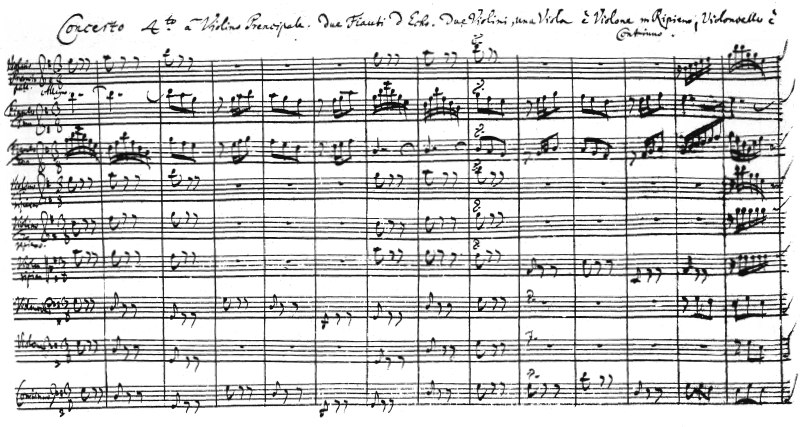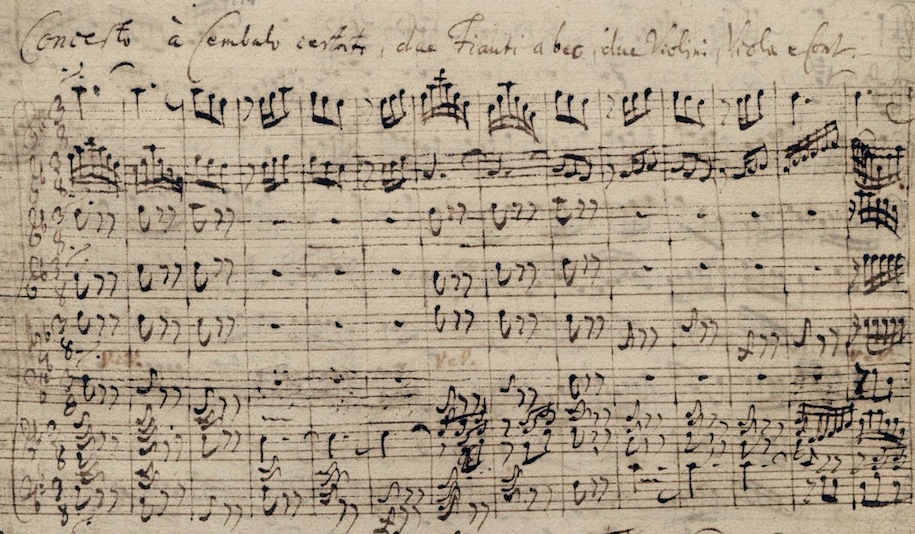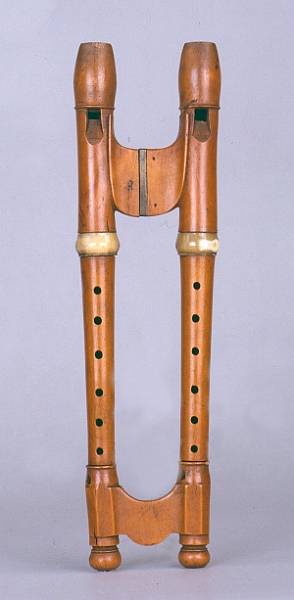Info updated: 2014-02-20
Bach's concertos and recorders in G
Subscriber Michaela asks if the first flauto part of Bach's Brandenburg Concerto N. 4 (BWV 1049) is intended for a G alto. Due to previous correspondence, Andrea Bornstein knows of my interest in this particular problem of instrumentation so he has forwarded the question to me. Michaela's request for only the first recorder part in G implies quite a bit of insight into the problem on her side, a problem that many readers may be unaware of. Therefore, before answering Michaela directly, I would like to summarize the problem for all of Andrea's faithful and happy subscribers.
There is quite a lot of literature and certainly just as much conjecture as to what instruments Bach intended for BWV 1049. So first, I would suggest glancing at the attached PDF «Fiauti d'echo controversy» taken from Richard Griscom and David Lasocki's book: The Recorder: A Research and Information Guide. New York: Routledge, 2003.
You won't find any answers to the question but you will certainly see how many people have tried to answer the question of what Bach meant by «fiauti d'echo».

Only Bach himself could tell us what he really meant by «fiauti d'echo». What follows is therefore a recount of my musical and practical reasoning on the subject of the instrumentation of Bach's 4th Brandenburg concerto.
Part One
Take a look at the following passage:

- Note the progression starting in the 2nd recorder part in bar 13 that leads up to a B4 (natural) in bar 14;
- The 1st recorder part answers in bar 15 and leads up to a C#5 in bar 16;
- The 2nd recorder part answers back in bar 17 and leads, logically, up to a D5 in bar 18.
Part Two
Let us now examine the following passage:

- Note the progression that starts in the 1st recorder part in bar 47 and leads up to an E5;
- The 2nd recorder part answers in bar 49 but, instead of leading up to a high F#5 in bar 50 Bach has transposed that note down an octave. The only logical reason that I can think of for bringing that high F#5 down an octave is that the 2nd recorder could not play the note. Obviously on a G instrument there would be no reason to transposed that note down one octave;
- The 1st recorder part answers in bar 51 and leads, logically, up to the G5 in bar 52 passing through a high F#5.
Now, if the score was intended for G altos, why would Bach have so obviously avoided the high F#5?
Part Three
BWV 1057 is Bach's transcription of the 4th Brandenburg, with the violin part given over to the Harpsichord and the whole concerto transposed down a major second. The reason it is transposed a tone lower (like BWV 1054, 1056 and 1062) was, in all probability, to allow the top note of the violin part, E5, to be reached as D5, the common top limit on harpsichords of the time. There is no doubt in anyone's mind that this concerto is intended for two F alto recorders that Bach calls «fiauti a bec».

Let us now look for a moment at the above passages from BWV 1049 as they are presented in BWV 1057.
Here you will see that the progression is completely respected. You will, of course also note that Bach has chosen to embellish the recorder parts by filling in the descending thirds with 32nd notes:

Part Four
Here is the bar 47-52 progression that in BWV 1049 had the transposed note:

Part Five
In BWV 1049 a low F3 that cannot be played on a G alto appears in the 2nd flute part in bar 183:

Bach solves this problem with elegance when transposing to F major by breaking up the 2nd recorder's note in measure 181 into two unequal parts and incorporating an octave leap and then removing the octave leap in measure 183:

Part Six
To me the above proves beyond a doubt that the 2nd recorder part was definitely not intended for an Alto in G. This does not of course preclude the first voice being played on a G alto nor does it answer the question as to why would Bach have given an F#5 to the first voice and not the second leaving us with two hypotheses:
- That Bach wrote it for two F altos but that he purposefully altered the second voice because the 2nd recorder (or the 2nd recorder player) could not play the F#5;
- That Bach wrote the concerto for one G alto and for one F alto (but gave us no indication of this in the score).
Personal experience has shown me that, although the first movement does indeed work quite well with two different pitched instruments, the 3rd movement is decidedly more problematic for tuning reasons because of the unisons having to be played with different fingerings. Therefore I personally still prefer to perform both BWV 1049 and 1057 on two F recorders.
So, how do I play the high F#5? I slur to (or, depending on the passage, through) the F#5 from an E5 by using the fingering:
 |
 |
| Ø 1 2 – 4 5 – – | Ø – – – 4 5 – – |
Note that the «Ø – – – 4 5 – –» fingering will not «speak» directly, it can only be obtained by slurring to it. If you've never done this fingering before you may have to work up to it by starting on the E5 fingering and doing short quick jumps with the 1 and 2 holes leaving them uncovered at first as little as possible and resisting the temptation to blow louder on the F#5.
Alternatively, for a performance at A=440, once could opt to use a Mollenhauer Modern Altos as Michala Petri and Nikolaj Tarasov so clearly showed us in their performance of the Brandenburgs directed by Claudio Abbado: [YouTube video].
One last point of interest, the Leipzig Museum has an instrument called an «echo flute» that has two recorders connected together, one with a quiet voicing and one with a louder one. See also this page

David Bellugi